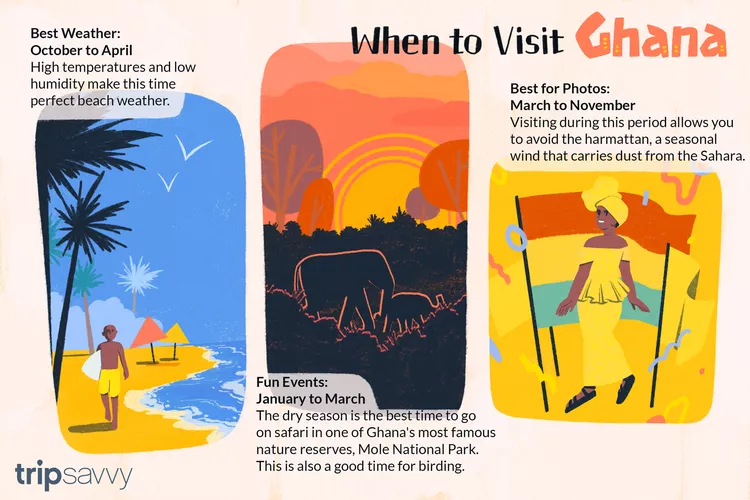Understanding the Weather
Generally speaking, the best time to visit Ghana coincides with the northern hemisphere winter (October to April). During these months, temperatures remain high; however, humidity and precipitation are at their lowest. There are many advantages to traveling during the dry season, the most notable being the reduced chance of wet weather days. Moreover, mosquitoes are less of a problem at this time, and the country’s secondary dirt roads are easier to navigate. However, better deals are often available out of season, making the May to September rainy season attractive for those on a budget.
Ghana is an equatorial country, and consequently, there is very little difference between its seasons in terms of temperature. Days are generally hot, and nights are balmy (with the possible exception of the country’s highland areas, where temperatures fall dramatically after dark). Although every region is slightly different, average daytime temperatures hover at around 85°F/30°C. Instead of hot summers and cold winters, Ghanaian weather is dictated by wet and dry seasons.
For most of the country, the wet season lasts from May to September, with the rainiest months occurring at the beginning of the season. In the south, there are two rainy seasons – one that lasts from March to June and another that lasts from September to November. There is one drawback to the dry season, which is the harmattan, a seasonal wind that carries dust and sand from the Sahara Desert into the country from the northeast. The harmattan starts around the end of November and lasts until March.
Visit the Coast
The coast west of Accra is home to beautiful beaches and landmarks, including the Elmina and Cape Coast castles. The country’s perennially warm climate means that it’s always suitable to wear bikinis and board shorts, and the humidity of the rainy season doesn’t matter so much when you’re by the sea (or the hotel swimming pool). If you’re worried about rain, the October to April dry season is best for coastal visits. If you’re a photographer, consider avoiding the harmattan, as it causes poor visibility and obscure skies.
Go on Safari
Ghana may not be the most obvious choice for an African safari, but there are nevertheless several worthwhile nature areas, the most famous of which is Mole National Park in the north of the country. The best time to visit is during the driest months (January to March). At this time, animals are drawn to water sources and the grass is lower, making them easier to spot. For keen birders, the dry season is also the most opportune time for spotting seasonal migrants from Europe and Asia.
Visit Accra
Situated on the coast in the extreme south of the country, Ghana’s colorful seaside capital offers a vibrant array of African culture and cuisine. Its location within the unusually dry region known as the Dahomey Gap means that precipitation is not as extreme here as it is in other areas of the south. The majority of the rains fall between April and July, with a second, shorter rainy season in October. The northern hemisphere winter is hotter but less humid, and for many, this is the optimal time to travel.





